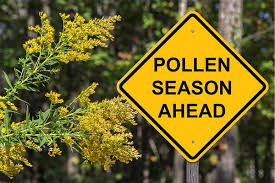Hello everyone.
This is Yoko Maeda, an internal medicine specialist at BIANCA.
Many people suffer during pollen season, unable to go out without a mask or glasses. Severe symptoms can lead to skin problems and interfere with daily life, making the cedar and cypress pollen seasons a dreadful time.
Today, I will explain the mechanisms behind hay fever and methods you can use to manage it yourself.
Mechanism of pollen allergy
Pollen allergy is, as the name implies, an allergic disease caused by plant pollen.
When pollen enters the body and is recognized as a foreign substance, IgE antibodies are produced to protect the body. These antibodies bind to mast cells found in the mucous membranes of the nose and eyes, which are related to allergy symptoms.
When pollen attaches to these mast cells, chemical transmitters that stimulate nerves and blood vessels are released, attempting to expel the pollen by stimulating the eyes and nose.
This leads to symptoms such as itchy eyes, redness, sneezing, runny nose, and nasal congestion in an attempt to remove the incoming pollen.
Treatments for pollen allergy
One option for pollen allergy management at clinics is anti-allergy medication, available in various forms, including oral medication and nasal sprays, each with different effects and side effects.
For those who cannot control their symptoms with anti-allergy drugs, subcutaneous injections of histaglobin or neurotropin can also be used.
In some cases, botox is used for pollen allergy treatment due to its ability to block neurotransmitters. Severe hay fever cases can also be treated with a highly effective medication called Xolair, which is now covered by health insurance.
Even if previous medications have not helped with hay fever symptoms, there is potential for improvement with these treatments.
Pollen allergy countermeasures at home
The human immune response works to remove foreign substances from the body. Improving gut health to regulate the immune system can also be part of hay fever prevention.
In daily life, avoiding foods that trigger inflammation is also crucial for pollen allergy prevention.
Foods that Are Likely to Cause Inflammation
- Sugar
- Wheat flour
- Dairy products
- Alcohol
- Omega-6 fatty acids found in sesame oil, mayonnaise, eggs, etc.
Foods Less Likely to Cause Inflammation
- Vegetables
- Foods with high-quality proteins like meat, fish, soy products
- Whole grains with low glycemic index, such as brown rice and rye
- Omega-3 fatty acids found in perilla oil, flaxseed oil, walnuts, etc.
Avoiding foods that cause inflammation and consciously eating foods that help reduce inflammation can alleviate hay fever symptoms.
Reducing the consumption of foods that promote histamine secretion can also help alleviate pollen allergy.
Foods that Promote Histamine Secretion
- Fermented foods like cheese
- Red wine
- Chocolate
- Spinach
- Bananas
- Pineapples
- Mushrooms
- Avocados
Including these foods in your diet is recommended.
Supplements for pollen allergy relief
Supplements can be an easy way to get nutrients that help manage pollen allergy.
Recommended nutrients for pollen allergy Relief
- Vitamin C
- Vitamin D
- Omega-3 (Fish Oil)
- NAC (N-Acetyl Cysteine)
Vitamin D, vitamin C, and omega-3 (fish oil) are all anti-inflammatory and recommended for everyone.
Additionally, NAC, a precursor to the antioxidant glutathione, helps reduce inflammation caused by hay fever, thins mucus, and prevents congestion and mucus buildup associated with allergy.
Small-scale clinical trials have also shown NAC’s effectiveness against ragweed. For those who find it difficult to manage with vitamin C, vitamin D, and omega-3, trying NAC could be a good option.
Points of Caution in Internal Treatment
Managing pollen allergy through diet and supplements is about improving one’s constitution. Rather than expecting immediate results, this approach focuses on conditioning the body. Therefore, starting 3-6 months before the pollen season becomes severe is recommended for prevention.
If you suffer from hay fever, feel free to come for a consultation. As an internal medicine specialist, I can propose an approach to enhance beauty from within.
Profile of Dr. Yoko Maeda, Internal Medicine Specialist
After completing initial training at Okinawa Nanbu Medical Center and Children’s Medical Center and working at the Department of Radiology at Kyoto Prefectural University of Medicine, Dr. Maeda encountered high-dose vitamin C therapy at a seminar by the IV Therapy Research Association. She then pursued studies as a research fellow at Riordan Clinic in the U.S. and passed the American Academy of Anti-Aging Medicine (A4M) board exam at the youngest age on record.
Currently, she is an internal medicine specialist at BIANCA. Her role is to approach beauty through health by caring for the body from the inside. As a professional in treating aging from within, she supports long-lasting youthfulness through personalized treatments such as natural hormone replacement therapy, peptide therapy, and supplement treatments tailored to each patient.
Affiliations and Certifications
- Director of the Japanese Society of Aesthetic Internal Medicine
- Board-certified by the American Academy of Anti-Aging Medicine (A4M)
- Fellow of A4M Anti-Aging, Metabolic, and Functional Medicine
- Board-certified in Chelation by the American College for Advancement in Medicine
For More Information on Dr. Maeda’s Aesthetic Internal Medicine
- Follow Dr. Maeda’s Instagram account [here].
- Follow BIANCA’s official Instagram account [here].
- Subscribe to BIANCA’s official YouTube channel [here].



